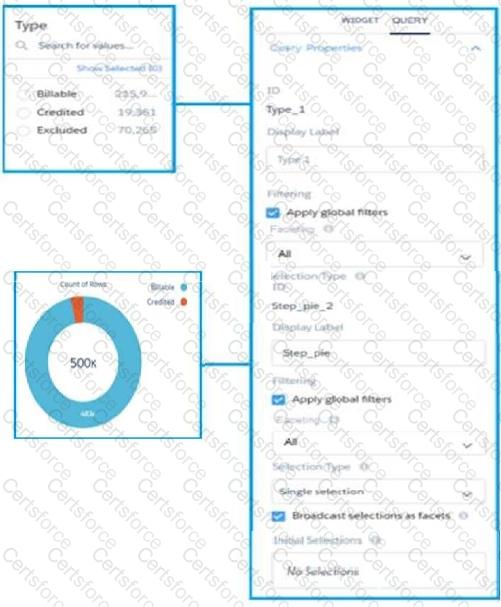Exhibit.

Given that the queries are using different datasets, which change should a CRM Analytics consultant make to solve this issue?
A manager at Cloud Kicks wants to separate and analyze accounts based on numeric information of its opportunity records. The data includes things like amount, quantity of products, contacts, and
quotes.
How should the CRM Analytics consultant accomplish this?
Cloud Kicks (CK) wants to use CRM Analytics to analyze trends of its sales pipeline in order to accelerate the company's sales process. To do so, CK needs to know the average time an opportunity
spends in each stage. The data can be found in the Opportunity History object, but the value is not pre-calculated in Salesforce, so a consultant recommends using a recipe to calculate it.
How should the consultant use a recipe to calculate the average time an opportunity spends in each stage?
Universal Containers wants to create two dashboards and has two user groups. The 'Regional Performance’ dashboard should be accessible to sales reps and managers/executives to keep track of
how sales reps are performing in each region. Sales reps must only be able to see data pertaining to their respective region. The ‘National Performance’ dashboard is using the same data as the other
dashboard but should only be accessible to managers/executives to compare data across all regions.
In addition to row-level security to view only regional data, how should a consultant ensure that sales reps are unable to view the ‘National Performance’ dashboard?
Universal Containers intends to use a custom Salesforce big object in its org and visualize the data using CRM Analytics. As the number of rows to be synced is quite large, the CRM Analytics consultant is looking to set up an incremental sync with additional filters added as part of the data sync to improve performance.
What should the consultant keep in mind while implementing this?
A consultant runs the sharing inheritance coverage assessment for the Opportunity object and finds that some records exceed 400 sharing descriptors.
What should the consultant do?
A CRM Analytics administrator is working on deploying a dataflow and a dataset (generated by this dataflow) to another org.
While creating a change set, they notice that the components are NOT visible to be included in the change set.
What is the reason for this?
A CRM Analytics consultant has enabled data sync manually in an org that uses dataflows/recipes. The client says that the dataflow/recipe fails each time it starts running.
What is causing the dataflow/recipe to fail?
A CRM Analytics consultant is adding direct data into an existing recipe. When trying to click on the input node, data preview is taking a long time to show any results.
How should the consultant resolve this?
A CRM Analytics consultant at Cloud Kicks is trying to upload data using an External Data API and the CSV file with the data wasuploaded successfully. Upon analyzing the data using a lens, they find
they are unable to perform any mathematical operations as all the data and fields are treated as dimensions.
What is causing the problem?